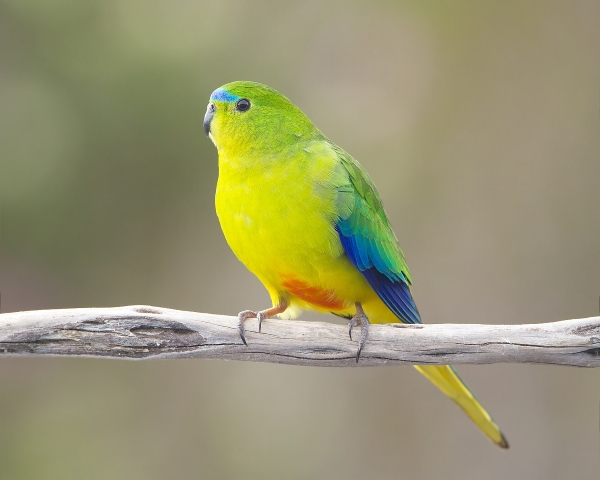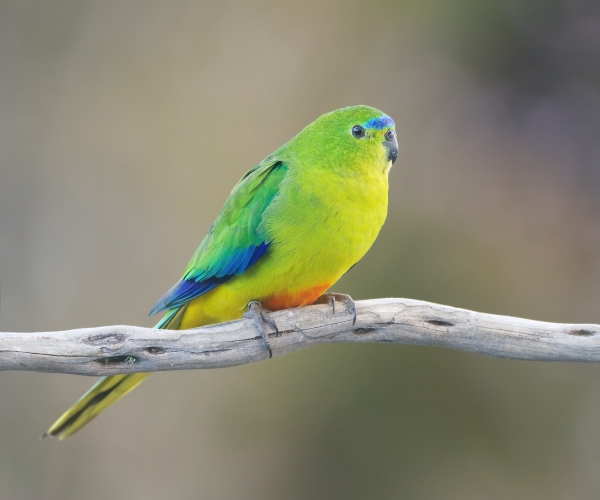If you’re searching for the prettiest bird in the world, then you should watch out for the magical orange-bellied parrot. Our universe cannot be complete without the colors of birds. If that is what you are looking for, the world’s most beautiful birds have an incredible variety of colors, patterns, and habitats. Indeed, birds are a gem of our mother nature. No one ignores the beauty of birds. In this article, we will explore the world’s prettiest bird, which is the orange-bellied parrot (Neophema chrysogaster). You will be breathless for a while looking at its colors.

Habitat: This prettiest bird species is on the verge of extinction and is restricted today to breeding only in Tasmania, where perhaps no more than 300 pairs survive. The bird feeds on plants found in salt marshes, on the beach or dunes, and a range of exotic weeds. Usually, the orange-bellied parrot spends the night in trees or tall shrubs up to one kilometer from where it feeds.
Identification: The bird can be identified as below.
Male: The male bird’s upper parts, including the crown, are bright grass-green. The frontal band is blue. The sides of the head, throat, breast, and flanks are mid-green. The belly is yellow, grading to bright orange in the center. The undertail coverts and underside of the tail are bright yellow. The underwing coverts and outer webs of dusky flight feathers are deep blue. The central tail feathers are green and washed with blue. The outer tail feathers are blue and broadly tipped with yellow. Eye brown. Bill and Cere are gray-black. Feet and toes are buff-grey. Female: As a male, but the upper parts are duller with the vague black frontal band. The immature bird is a little duller than the adult female. Although it is well-marked, it has a smaller orange belly patch. A yellow underwing stripe is present. The downy young bird is white with yellow bills.
Diet: Seeds of grasses, shrubs, salt-adapted plants, and fruit are their food, though they have been seen eating decaying kelp. Beaded glasswort and shrubby glasswort are the two most significant food plants for them. Additional food sources comprise the seeds of various plants such as sea heath, saltbush, coast fescue, and Austral seablite, in addition to berries like Coprosma.
Vocalizations: The orange-bellied parrot contact call is generally in flight, of soft ‘tinkling’ notes, that are repeated every one to three seconds, like the call of a blue-winged parrot. The alarm call is a buzzing chitter-chitter. Parrots that have been flushed from cover may produce this call. Birds serving as sentries at feeding places make the gurgle-buzz call, which is a combination of an alarm call and hissing and chattering. Orange-bellied parrots may chirp softly and low to the ground when they are eating.
Behavior: Orange-bellied parrots spend most of the day on the ground, either searching for seeds or quietly sitting under a tussock or small bush. In the field orange-bellied parrots are identified by their bright grass-green plumage and distinctive buzzing alarm call, given as they are flushed to rise high in the air before dropping again. Although breeding and feeding in the fens of western Tasmania, they keep close to coasts throughout the year, foraging on tidal flats, sedge swamps, and grass fields. At their wintering quarters, the parrots congregate in small flocks, dispersing to breed in pairs.
Nesting and Breeding: The Orange-bellied Parrot nesting and breeding occur in November-December. The nest is made of a bed of rotten wood chips in hollows in living eucalypts. Their nests are located in hollows in mature trees, generally in the Smithton peppermint or occasionally in the swamp gum. The entrance to the hollow is a 6–10 cm-wide hole in a broken limb or trunk, and it can reach a depth of up to 24 inches.
Eggs and Incubation: Before laying the eggs, the female usually spends a few days in the nest. The orange-bellied parrot lays four to six eggs, white and rounded, about 22 x 18 mm. The incubation period is 20–21 days for a female. Both parents take on the responsibility of feeding the young. After 10 days, the young fled in four to five weeks. The young are nidicolous and semi-altricial, meaning they are born blind and defenseless and spend a considerable amount of time in the nest.
Distribution: Orange-bellied Parrot is only found in Tasmania, rarely more than 60 km from the coast, and the coastal southern mainland. Frequent open grassland and light scrub, dunes, tidal flats, cultivated paddocks, and swamplands.

Where does the orange-bellied parrot live? The primary locations of this bird are in or near Port Phillip, including French Island in Western Port, the Werribee Sewage Farm, the Spit Nature Conservation Reserve, the coasts of Swan Bay and Swan Island, Lake Connewarre State Wildlife Reserve, Lake Victoria, and the Mud Islands.
Why do orange-bellied parrots migrate? They only migrate in winter as far as the south coast of mainland Australia, between Port Phillip Bay and the Coorong. Just three species of parrots migrate, and this one is one of them.
Similar Species: The orange-bellied parrot and, blue-winged parrot are similar in appearance but can be distinguished by their lighter olive-green upperparts and tinkling alarm sounds. Only one side of their blue frontal bands is bordered with light blue. Elegant female blue-winged parrots feature golden plumage above and behind the eyes.
Flight: The Orange-bellied Parrot’s flight is like that of the Rock Parrot, and display and nesting habits are like those of other Neophema parrots.
Size: Orange-bellied Parrot size is about 200–210 mm long (8 inches), including a slender tail.
Status: It is thought to be a severely endangered species on the IUCN red list. The primary reason for the significant decline has been habitat degradation and loss, especially in the non-breeding range.
Family: The orange-bellied parrot (Neophema chrysogaster) is a member of the old-world parrot family Psittaculidae in the genus Neophema.
Life Cycle: The average life cycle of an orange-bellied parrot is just over two years.
Races: There are no races to exit.
However, the facts about the orange-bellied parrot indicate that this parrot is without a doubt the prettiest bird in the world. You are the luckiest person if you can see it.
Read More: Mulga Parrot
